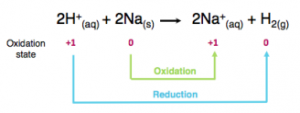Oxidation, Reduction and Redox Equations - Redox Processes (A-Level Chemistry)
Redox Processes
Redox Reactions
A redox reaction is when both reduction and oxidation happen at the same time.
In redox reactions, there is a transfer of electrons between two species: the electron donor will be oxidised whilst the electron recipient will be reduced.
Example: Metal Salt Formation
A typical example of a redox reaction is the reaction between a metal and an acid to form a salt, like for instance, that between sodium metal and hydrochloric acid.

This equation can be written as an ionic equation, in which compounds in aqueous solution are written as dissociated ions.

As you can see, chloride ions have remained unchanged before and after the reaction. They are said to be spectator ions, as they do not take part in the chemical reaction and their oxidation state remains unchanged. They can be cancelled out.

Once we have the ionic equation for the reaction, it is easier to identify reduction and oxidation reactions by looking at changes in oxidation states.

Remember that in an oxidation reaction there is an increase in oxidation state and that in a reduction reaction there is a decrease in oxidation state.
Disproportionation Reactions
A disproportionation reaction involves an element in a single species in a chemical reaction being simultaneously oxidised and reduced.
For example, when dilute chlorine reacts with a dilute alkali, some chlorine atoms are reduced and some are oxidised in the same reaction. Chlorine atoms are reduced to give chloride ions and oxidised to form chlorate(I) ions.

The oxidation state of chlorine has both increased and decreased.





Still got a question? Leave a comment
Leave a comment